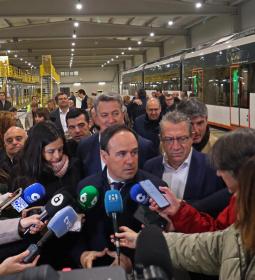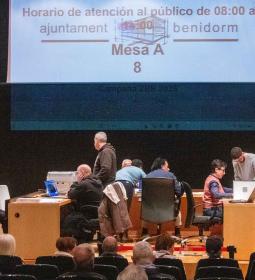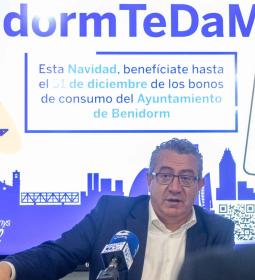The plan will be approved in full this month and is ahead of regional regulations
Benidorm presents its Adaptation Plan to Climate Change, a pioneer in Spain and with 54 actions, some already underway

Benidorm has already completed its Climate Change Adaptation Plan (PACC), a pioneer in Spain and which includes 13 strategic lines of work and 54 actions to be developed in the short and medium-term. The mayor, Toni Pérez; Jorge Olcina, professor of Regional Geographic Analysis at the University of Alicante (UA); the technical director of Climate Intelligence, Pablo Mirete; and the chief engineer of the City Council, Vicente Mayor; presented today the outlines of the document, which will be approved at the end of the month in plenary session.
Both the mayor and Jorge Olcina have stated that the PACC is "a roadmap" of where municipal action should go in order to achieve a double objective: "avoid continuing to harm the planet with human action" and "adopt measures to mitigate the effects of climate change” on the territory and also on “the economy and society”.
Toni Pérez has indicated that with this document Benidorm is developing its own action plan in anticipation of regional regulations, and has clarified that "some of the 54 actions" included in the PACC are already "being implemented" as is the case of the Zone of Low Emissions in the Spanish Navy.
The mayor recalled that at the end of 2019 Benidorm took the gauntlet thrown by Jorge Olcina himself, who advocated that cities with more than 50,000 inhabitants develop a plan of these characteristics. The City Council then assumed "its commitment" to develop a PACC that is already finalized and that will mark other municipal plans underway.
During this time, work has been done on the climatic trends that are expected for the municipality in the next eight decades, which marine and terrestrial spaces to protect, the influence of climate change on the coastal strip, on its possible impact on the social and economic sectors –with special attention to tourism-, and in raising awareness and disseminating measures.
Jorge Olcina has also highlighted Benidorm's commitment to adapt to climate change by indicating that it is “the first city with more than 50,000 inhabitants that has a plan of this type; It is a city that wants to prepare for the future.” At that point, the professor has influenced the compact city model of Benidorm as "the most sustainable and efficient". For this reason, he has said, "with this plan we wanted Benidorm to be the sample button that would activate other municipalities in the Valencian Community".
Olcina has exposed the current global situation and has focused on the Mediterranean area to advance that "it will have more frequent extreme manifestations because we cannot reduce CO2 levels". This will result in a greater number of tropical nights - "we no longer drop below 90 a year" - and changes in the seasonality and amount of rainfall.
To combat climate change there are two ways, explained Olcina, which are "mitigation, by reducing emissions, and adaptation". In this sense, he has stressed the importance of local administrations and the actions they can carry out. “Municipalities must get their act together as soon as possible” he added.
With regard to Benidorm, he specified that the plan has established a series of risks by sector and, according to these indicators, "everything related to tourism and urban planning is the ones that present the least risk because they are the ones that have been known to prepare in the last years". A statement that he has extended to the City Council, "which has worked for years on sustainable urban planning and efficient water management."
Finally, referring to the Climate Change Adaptation Plan, he stressed that it is "a medium and long-term plan, a roadmap, a strategy that sets the tone to follow". “There is no going back and the longer the municipalities take to understand it, the worse it will be for them” he concluded.
Broadly speaking, to increase Benidorm's resilience against climate change, the document proposes to renaturalize the municipal area, thereby also improving the quality of life. In this regard, he recalled that the City Council has requested a grant from Next Generation funds to develop a project along these lines.
It also proposes promoting the conservation of biodiversity; improving the design and adaptability of the city; promoting the use of renewable energy, self-consumption and efficiency and raising awareness to inform society seeking the proactivity of residents and tourists, and enhancing the impacts of tourism. And all this, is coordinated by an internal body that will oversee the implementation and development of these measures.







